PPC
What Is Digital Advertising? Types, Benefits & Examples (+Pro Tips!)

Digital advertising is one of the most effective ways for businesses of all sizes to expand their reach, find new customers, and diversify their revenue streams.
That is, if you know how to navigate it right. Each ad network has its own unique strengths that you need to play to if you want to actually get a return on your investment.
And that’s why I’ve written this guide! In it, I’m going to distill the complex world of digital advertising down into its four core channels and show you how to harness the power of each one to grow your business.
Let’s get started.
Table of contents
What is digital advertising?
Digital advertising refers to any and all digital means of what many people call “paying to play.” You pay to get your business to appear on popular online channels, including search engines, social media platforms, websites, apps‚ and more.
Types of digital advertising
There are four core channels of digital advertising: search, display, social, and video.
Search advertising
Search advertising is also known as paid search, PPC, search engine marketing, search ads, or text ads.
Search ads are the text-based ads you see on the search engine results page (SERP). They appear based on what a user has searched and can be seen at the top of results, at the bottom, and sometimes on the side. You can run search ads on Google or Bing, but Google is the go-to.
Search ads also include Shopping ads, as there is a Shopping tab on Google, and Shopping ads can also appear on the regular Search tab:

Display advertising
Display ads, also known as banner ads, are the ads you see on websites and apps. Unlike search ads that are text-based, these are image based and they come in all different shapes and sizes. There are tons of networks you can run display ads on—the Google Display Network, of course, being one of the most popular.
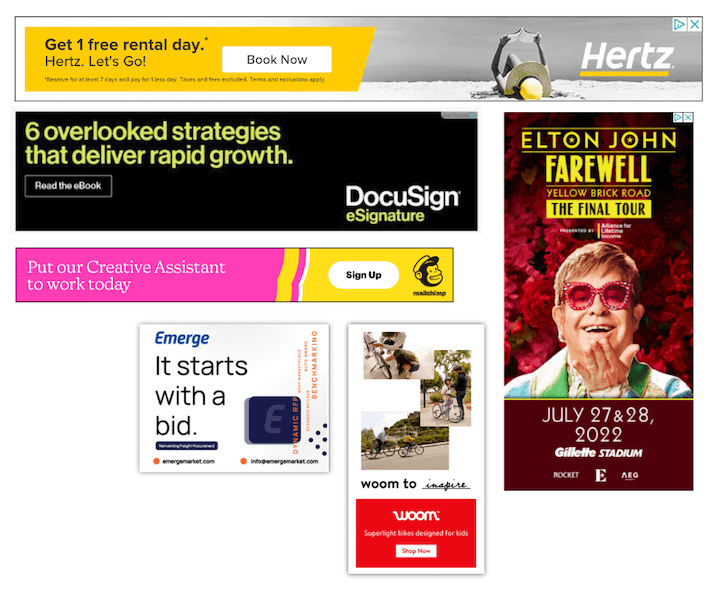
Social media advertising
Social media advertising refers to ads on popular platforms like Facebook, Instagram, Twitter, LinkedIn, TikTok, and more. Like display ads, they come in many formats and placements and support a range of creative, from images and video to immersive mobile experiences. Facebook is the most versatile platform for businesses, so that’s what we’ll be focusing on in this guide.

Video advertising
Social and display networks support video ads, but we’re talking about video as a channel here rather than a format. The world of video streaming and OTT can be complex, but what is *the* video channel? YouTube of course. YouTube ads include both video ads that play before, after, and during videos; as well as non-video ads that appear over videos and in search results.

Benefits of digital advertising
First and foremost, digital advertising is very cost-effective, first because it’s pay-per-click (or depending on what platform you’re using, it could be pay per impression, pay per video view, etc.)—you only pay when someone takes the desired action of your campaign. Even better, the targeting capabilities that come with digital advertising make it such that you’ll get the most qualified people to take these desired actions.
And to top it off, each digital advertising channel has its own set of benefits. Let’s take a look.
Benefits of search ads
Intent to buy is highest on search engines, and since you’re targeting keywords, your ads can appear for people searching for exactly what you have to offer. In fact, 89% of buying journeys begin with a search engine, and for commercial intent queries, 65% of the clicks go to paid ads. No wonder the ROI is 200%!

Benefits of display ads
Display ads build brand awareness, which is a top goal for 89% of marketers. Why? Because it feeds into the success of every marketing campaign you run—including your search ads. In fact, one study found that 27% of consumers conducted a search for a business after seeing its display ad, and that there was a 59% lift in conversions when users conducted a search related to a display ad. And we haven’t even talked about retargeting yet! 92% of marketing professionals say that retargeting display ads perform at the same level or better than search marketing.

Benefits of social ads
While intent to buy is highest on search engines, you shouldn’t only be targeting people in your audience with purchase intent. Enter: social, where there is intent to engage and discover.
Similar to display ads, social media ads build brand awareness due to the reach of social networks and their creative design capabilities. They’re also minimally disruptive, since they blend in well with users’ feeds and can be liked, shared, and commented on.
The cherry on top is that because users share detailed information about themselves on the platforms, social media ads allow for granular targeting. This makes social ads the perfect impulse enablers. They allow you to get in front of users when they’re open to taking action.
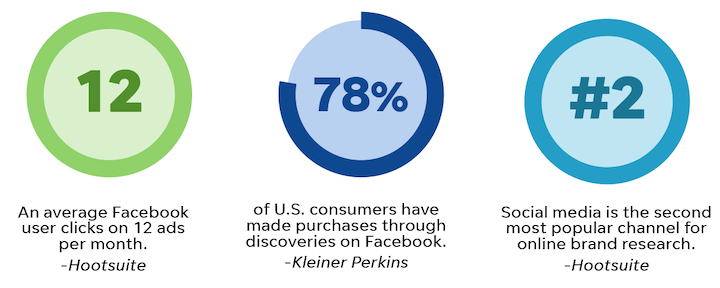
- An average Facebook user clicks on 12 ads per month.
- 78% of U.S. consumers have made purchases through discoveries on Facebook.
- Social media is the second-most popular channel for online brand research.
Benefits of video ads
We all know that video content holds power. It can inspire need through creative storytelling, make someone aware of their candidacy for a product or service, simplify complicated offerings, and build positive sentiment toward your brand.
While you can run video ads on Facebook and other display placements, they are often played with the sound off, and this is not the primary reason people turn to social media or websites. On YouTube, however, users are looking for visual, audible experiences—not to mention the fact that it is the second largest search engine in the world—making it the perfect place to reach your audience with education, entertainment, and emotion.
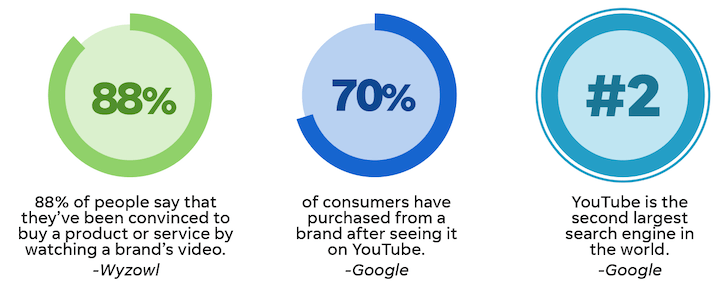
88% of people say they’v been convinced to buy a product or service by watching a brand’s video.
YouTube is the second-largest search engine in the world.
70% of consumers have purchased from a brand after seeing it on YouTube.
Digital advertising examples
We have tons of digital advertising examples for you to browse.
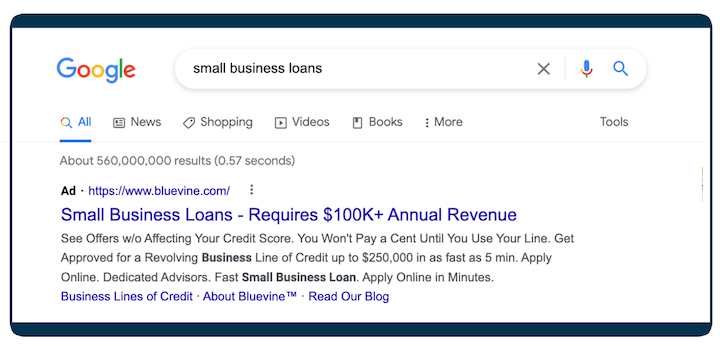
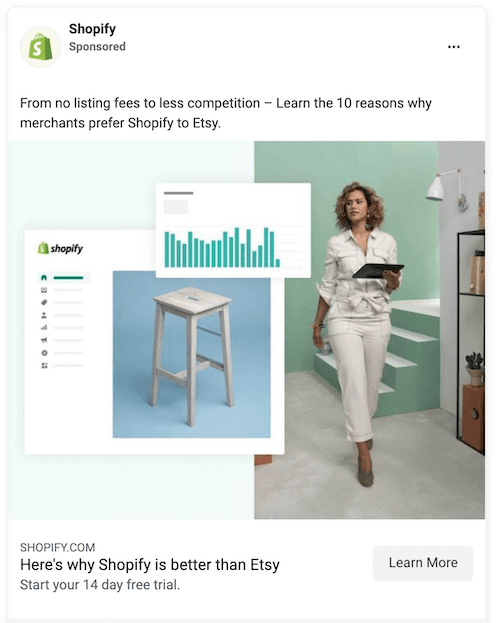

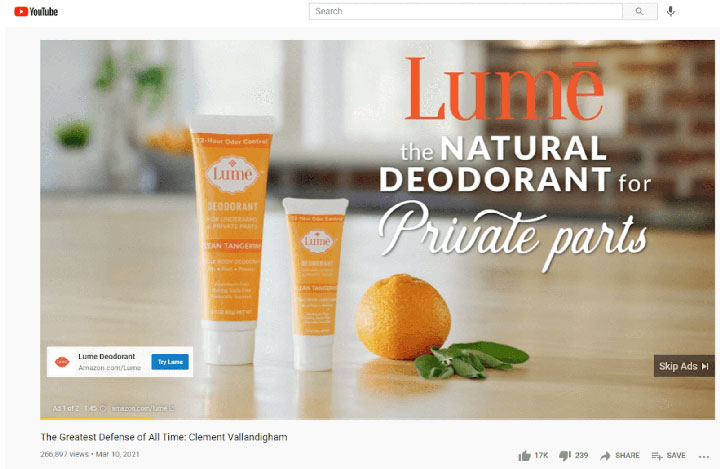

Digital advertising tips
Each digital advertising platform is a little different, so here are our best digital advertising tips, broken down by channel.
Search advertising tips
If you’re new to search ads or want to brush up on the fundamentals, these are the core things you need to nail down.
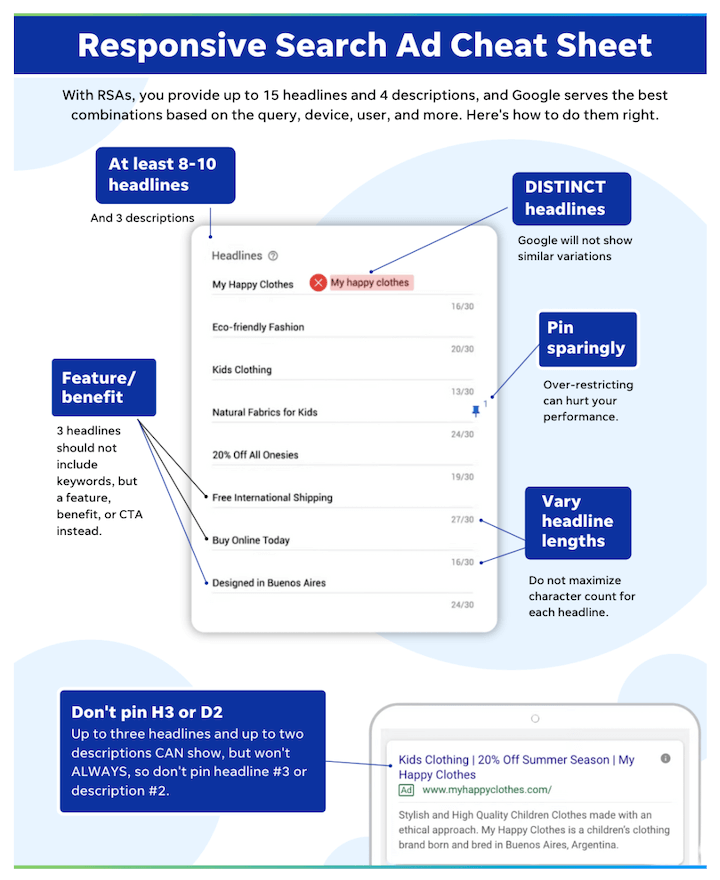
If you’re a little further along in your search ad strategy, here are some more advanced tips:
1. Understand the nuances of Quality Score
Maintaining a high Quality Score is important because Google rewards high-quality ads with higher positions and lower CPCs (hence why it’s our #1 in starter tip). You can do this by keeping your click-through rate up; tightly aligning your ads, landing pages, and keywords; and optimizing the landing page user experience.
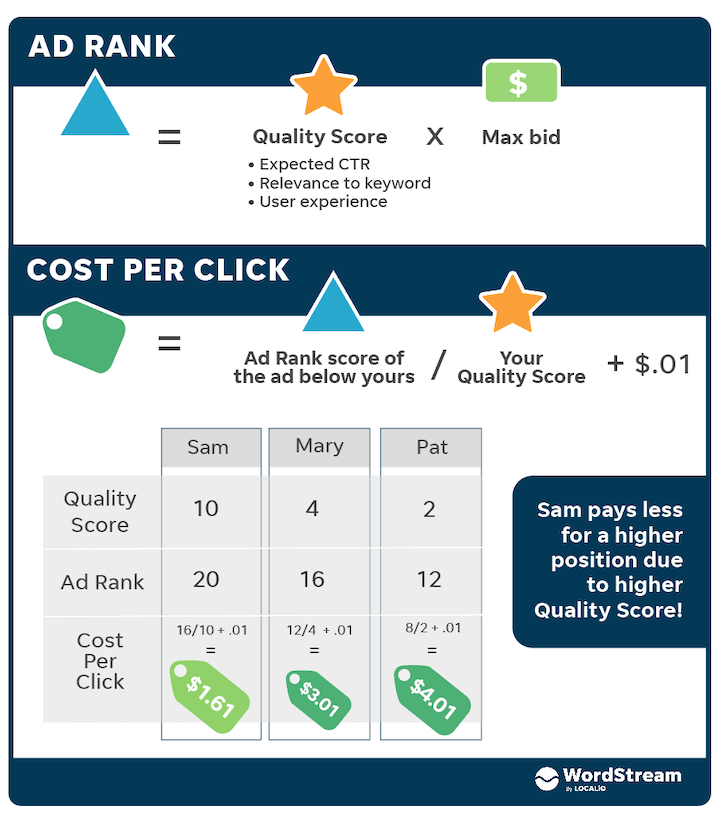
But a healthy Google Ads account has a mix of campaigns, and a Quality Score of 10 is just not realistic for some keyword types. Here’s what’s considered a good Quality Score for different types of keywords:
- Branded keywords: 8-10
- High commercial intent keywords: 7-9
- Low commercial intent keywords: 7
- Competitor keywords: 3+
Keep these in mind when creating your campaigns!
2. Theme out your ad groups
The way you organize your campaigns and ad groups impacts how easy it is for you to manage your account and how effective your ads are, which impacts how much they’ll cost.
You can organize your campaigns according to what works best for you—such as by types of products or services you’re advertising, or by geographic location. What’s more important is that the ad groups within those campaigns are grouped by theme.
This is because you can only have one landing page per ad group, so this will ensure your ads and landing pages are super relevant to the keywords you’re targeting (to keep your Quality Score high).

3. Get feisty
What makes search advertising so effective is also what makes it so competitive, so you need to be in it to win it! For starters, you’ll want to bid on your competitors’ brand terms—chances are they’re already bidding on yours.
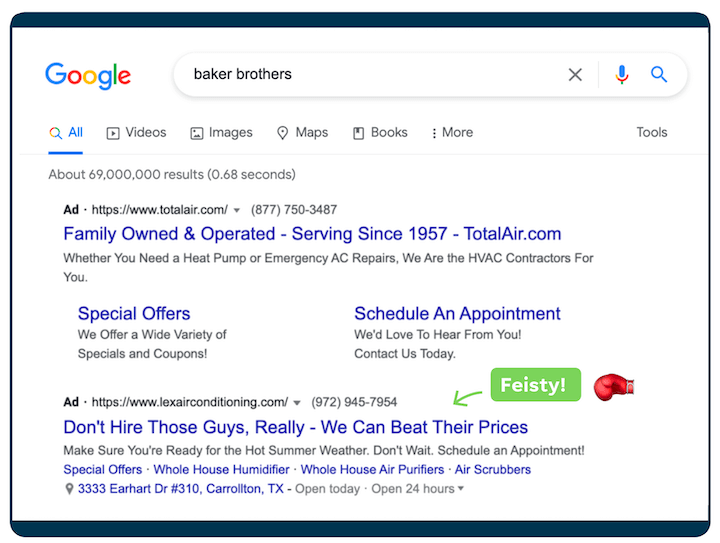
Also, use competitor keyword research tools to find out the other keywords they’re bidding on. Some keywords you’ll be able to target head-on with better offers. For others where your offer isn’t as strong, use extensions and exceptional ad copy to improve your click appeal. Appearance, enthusiasm, and words sell!
And don’t forget the weak spots—keywords they’re not focused on that you can capture clicks for.
4. Be a keyword connoisseur
At the heart of a successful Google Ads campaign are the right keywords. But it’s not enough to just do your keyword research, input the list into your ad group, and call it a day. You need to regularly maintain keyword lists and seek out new keywords to target. Here’s how:
- Use the search terms report: to find cheaper, higher-converting keywords that have less competition; new keywords to add to your ads; and negative keywords to block that are wasting spend.
- Isolate low Quality Score keywords: Remove the ones with low Quality Scores and put them in their own ad group with hyper-focused ads and landing pages. If you can’t get a lift in performance there, you may want to pause or delete them if they’re not valuable enough for your business.

5. Adequately fund your campaigns
All too often, we see accounts that fall into this scenario: Average CPCs are $10+, they have many high-quality, well-focused keywords, but the daily budget is spread across 5-10 campaigns, each getting only $5/day—not even enough to cover one click.

This is why keyword research (starter tip #2) is so important! Luckily we have a Free Keyword Tool for that!
Google Ads adjusts and optimizes the delivery of your ads based on real-time performance data. If you underfund your campaigns, your ads won’t serve frequently enough to give Google the data it needs to make those optimizations and give you a return on your investment.
If you’re so tightly strapped for cash that you have very low budgets, there are plenty of ways to save money in Google Ads while sticking to your guns. If you’ve covered all those bases, prioritize your account. Pick the campaign or keyword set you think is going to perform best, turn off all others, and divert all of your budget to that group. Let it run for a while and evaluate performance. If you’re seeing results, keep going. If not, pause that group and move on to the next.
Display advertising tips
Here are some basic tips to help you turn your display ads into audience- and awareness-building all-stars.
- Get savvy on sizes, specs, and setup. Our cheatsheet to display ads covers everything you need on this front.
- Arm yourself with design best practice and creative ideas: You’re not dealing with just blue text like in search ads. These display ad examples will give you inspo, intel, and best practices around creative design.
- Make friends with audience targeting. While search ads are keyword-based, display ads are audience based. You need to know all the audience options available to you!
Those are just the basics. If you are looking to really optimize your display campaigns, follow these tips:
1. Carefully curate your audiences
The main goal with display advertising is that of gaining impressions and brand awareness. But if you want that volume to have a true impact on your other campaigns, you need to carefully curate your audiences. Here are some sources to explore:
- Referral traffic report (Google Analytics): Go to Acquisition > Referral traffic to see which websites are linking to yours the most. This can help you understand which websites cater to people that could benefit from your product or service.
- Audience report (Google Analytics): Head over to the Audience > Interests > Overview to see which affinity and in-market audiences your current website visitors fall into.
● Audience Insights (Google Ads): Head to Tools>Shared Library>Audience Manager and look at affinity and in-market characteristics for any list or segment—all users, all converters, blog subscribers, and users who logged in on the site, for example. You’ll see that these qualities change based on which segment you’re looking at.

2. Strategically retarget your engagers
With retargeting campaigns, you can serve ads to people based on their previous engagement with your business, such as products they’ve viewed but not yet purchased, content they’ve downloaded, solutions they’ve viewed, and other ads they’ve engaged with.
Why might you do this? Well, the average click-through rate for retargeting display ads is 0.7%, which is 10 times higher than that of regular display ads. And a website visitor who’s been retargeted with a display ad is 70% more likely to convert.
If you want to run all-star display ads, remarketing campaigns must be in your mix (just avoid these remarketing mistakes!).
3. Conduct placement audits
A good advertiser will choose their audience targeting parameters and then call it a day. A great advertiser will look at how the placements within those audiences are performing and refine further with exclusions.
For example, mobile app and game placements tend to be a waste of budget—too many accidental taps. You’ll also find among your successful placements that some are the cream of the crop. So conduct placement audits to see which ones are offering the most value.

4. Know how to measure their success
As we’ve touched on, most industries don’t see a ton of direct conversions from their display campaigns. With the bulk of their magic going on behind the scenes, how do you measure their success?
The all-star advertiser knows how.
The simplest way is through view-through conversions. A view-through conversion happens when a user sees your display ad, does NOT click on it, but then later returns to your site (whether by organic search or direct) and completes a conversion then.
That being said, customize your Google Ads settings to include view-through conversions and use a short lookback window (the amount of time that elapses between impression and conversion).

This metric will never be as certain as click-through conversions, but we have reason to believe we can trust it. We also have some more advanced strategies for measuring the impact of your display ads on search campaigns here.
Social advertising tips
To succeed with Facebook advertising, here are some tips that will get you on the right track:
- Learn account and campaign setup: Our Facebook ad tutorial will walk you through creating your first campaign.
- Take on Aggregated Event Measurement: This is an additional part of setup that has to do with privacy changes. Use our AEM tips to understand what they are and how to prioritize your events.
- Nail down how Facebook targeting works: Targeting has long been Facebook’s bread and butter, but it has changed a bit due to privacy policies. Our Facebook Ad Targeting guide will get you up to speed.
And now, some more Facebook advertising tips to help you take things to the next level:
1. Build a full Facebook ads funnel
When you’re paying to play, it’s tempting to only promote bottom-funnel offers that will bring in direct profit. But this can actually backfire on you. Remember, not everyone in your audience is going to be ready to purchase right away—and it’s not about what’s highest value to you, but what’s highest value to your prospects at each stage in their buying journey.
So use a variety of campaign objectives within Facebook ads to promote offers that range across your funnel. With a full-funnel strategy, you can capture leads, nurture them, and retarget them with higher value offers—and as you can see, this can make a world of difference in your conversion rates and ROI.

2. Organize your campaigns by objective
Too many times, advertisers break out their campaigns according to who their targeting rather than what their objective is. So let’s say you have an SEO ebook for small businesses. You have three different variations of the ebook—one for physical therapists, one for interior designers, and one for lawyers.
Instead of creating three separate campaigns for each audience, the better way to go is to create one campaign for the ebook and then within the campaign create three ad sets for each audience. This is how Facebook campaigns and ad sets are meant to be used.
With this proper Facebook ad account structure, you can more efficiently manage and optimize your ads as well as scale your efforts and offers.

3. Consolidate your conversions
Once your pixel is set up, you can then tell Facebook which conversion events you want to track. Back to our SEO ebook example, you could set up a separate conversion event for each ebook download, but if you do, this is what you’ll see when you’re at the campaign-level view:

There’s no way to see conversion counts at a glance. You’ll have to dig into each ad set’s data to look at how many total conversions you’re getting from the campaign.
But if you create one ebook download conversion event, you can then get a total conversion count quickly from the campaign view. It’s a small detail that can save you time and help you make decisions faster.
Plus, with Aggregated Event Measurement, you’ll want to consolidate your conversions as much as possible. Events outside of your eight priority choices will not be reported on if they’re taken by iOS 14+ users who have opted out of Facebook tracking.
4. Learn how to get creative
Understanding who your people are and how to inspire their desire is key to winning at paid social. While this used to be child’s play in years past with all the native targeting, privacy changes have thrown a wrench into things. But that doesn’t mean you can’t get creative. And we have lots of clever workarounds for you to try. For example:
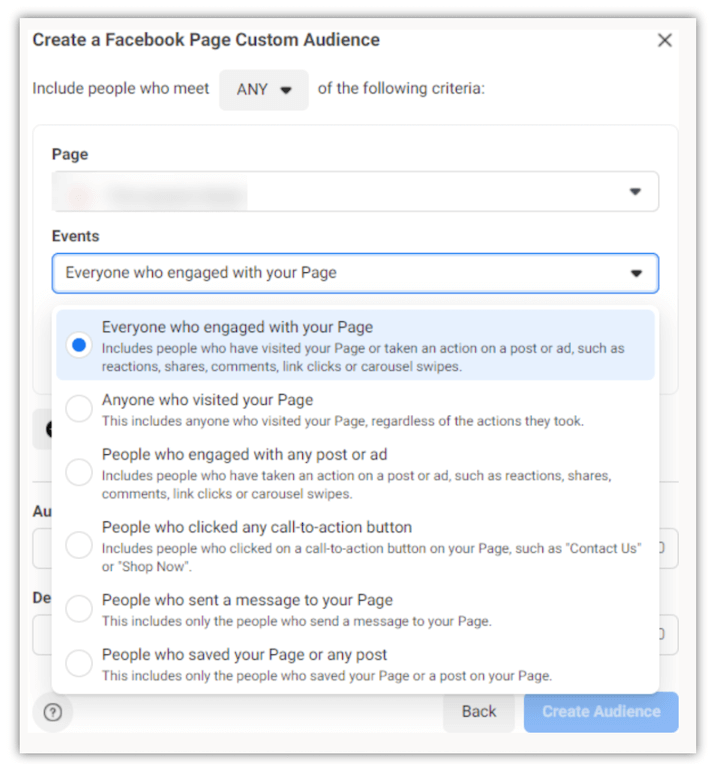
- Aggravated with Aggregated Event Measurement? Capture leads on Facebook directly with lead form ads or click-to-messenger ads.
- Bummed out by the restrictions on targeting based on employment, real estate, and finance targeting? Use in-market audiences on Google, which still offer this kind of targeting, to get traffic to your site that you can use as a source audience for a Facebook lookalike campaign.
5. Be more strategic with interest targeting
Despite privacy restrictions, Facebook still offers detailed targeting on a number of different interests. But instead of targeting an interest identical to the product or service you’re advertising, think outside the box a bit. Consider the following:
- Competitors: Even if you’re not getting clicks, you’re generating brand awareness among their audiences.
- Parallel interests: If you’re advertising toys, you might target children’s clothing. Or if you’re advertising workout equipment, you might try people interested in electronic music or healthy recipes.
- Adjacent audiences: Look at influencers and institutions in your industry that have pages with large followings. There you’ll also find related pages, pages liked by that page, and top fans. You can then go to their profiles, add “/likes” at the end of the URL and then see what they have liked.

YouTube advertising tips
Here’s your starter kit for advertising on YouTube.
And here are some more advanced YouTube advertising tips to consider:
1. Prioritize the first 5 seconds
The best video ads understand that users likely won’t see past the first five seconds. While some lean into the six-second bumper ad format (equal part art and science), others attempt to persuade the user to stick around for the full ad.
Pragmatically, make sure you have your business name and a call to action and/or contact method in the first five seconds.
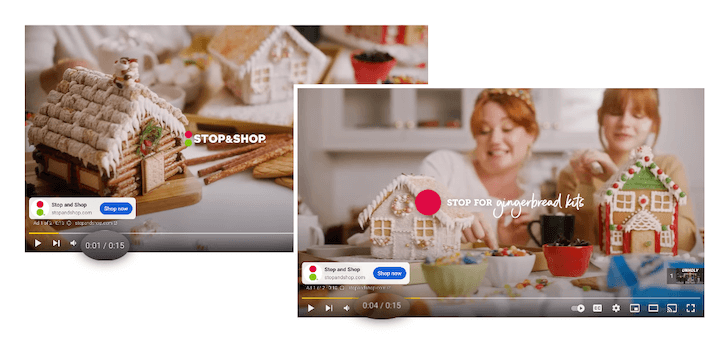
2. Use YouTube Studio analytics
There is a lot of data you can get in YouTube Studio that you can’t get with regular Google Ads reports. For example, you can look at device reporting in Google Ads, but if you look in Studio, you can add additional metrics like card clicks.
This is important because when looking at devices only, it appears as though TV, tablet, and game console devices bring in a decent number of views.
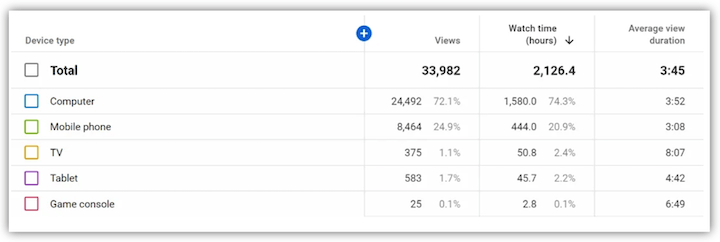
But when you add in card clicks and average percentage viewed, we can see that while average view duration is longer for TV and Game console, these devices have zero clicks.

This is because TV and Game console devices will not show cards, so if you’re running a TrueView discovery campaign, you’ll be paying for those video views even though they’re not converting.
Unless you’re also striving for awareness or video engagement, the metrics in this view suggest that you only run your campaigns on Computer or Mobile phones. View more YouTube Studio report tips here.
3. Be aware of fine-print settings
There are some fine print settings when setting up video campaigns in Google Ads that you should be aware of. For example, Video Action campaigns support call-to-action extensions, sitelink extensions, and more to encourage users to visit your website.
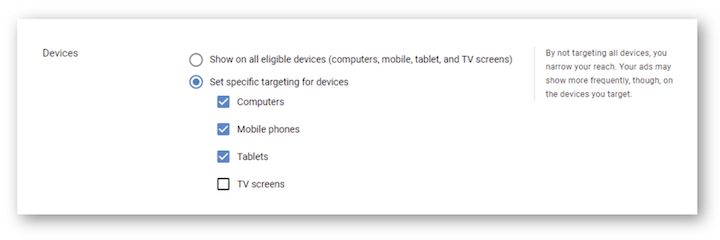
But according to Google, “The call-to-action button on TVs is only available for Video campaigns that use the “Brand awareness and reach” and “Product and brand consideration” goals. In other words, these extensions won’t show up on most TV devices. So if you’re running a Video Action campaign, turn off this placement.

TV device targeting isn’t worthless—many people watch TV with their phones in their hands and after seeing your ad they could easily look up what your brand or product is. But if you want to capitalize on TV devices, split it out into its own campaign. You’ll have better control of the budget and get better insight on how your Action campaigns perform both on and off TV devices.
4. Set a frequency cap
Aside from creative, it’s important to remember video ads interrupt content a user actively chose to engage in. If you serve the same ad (or ads in the same series) to people too frequently, they will eventually tune you out or develop bad brand sentiment.
Be sure you set a frequency cap for daily/weekly views. A good place to start is five views per week and adjust from there.
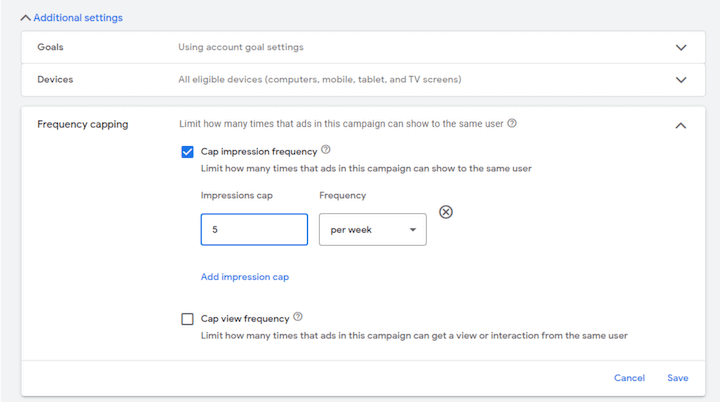
Digital advertising 101: Wrapup
Whether it’s search, display, social, or video, all ad channels have a place on your digital advertising team—as long as you know how to play to each one’s strengths. Hopefully, this guide has given you an understanding of those strengths so you can assemble each ad into a lead-, sale-, and ROI-generating machine for your business.



















You must be logged in to post a comment Login